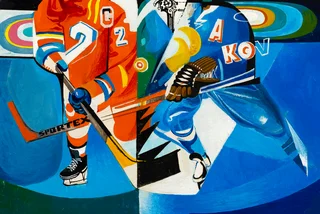Any art lover will surely have ventured into at least one of the National Gallery Prague (NGP) sites. Few, however, have tapped into the full potential of what one of the oldest art galleries in the world has to offer.
Founded in 1796, NGP is one of the largest of its kind in Central Europe. Over 400,000 artworks and collection items are now housed in over half a dozen venues across the city.
Gathering the most beautiful and innovative artworks that have originated from the Czech lands throughout history, it also houses masterpieces of international art – names like Picasso, Rubens, van Gogh, Schiele, Dürer brush shoulders with Toyen, Filla, Kupka, and Sýkora.
Medieval Madonnas, Dutch masters, and Cubist wonders
NGP caters to all tastes, with this eclecticism reflected in the sites and venues where permanent collections and temporary exhibitions are displayed.
If one-armed Madonnas, sorrowful Pietas, and graphic Crucifixions are your cup of tea, visit the 13th-century Convent of Saint Agnes, a peaceful haven between the Old Town and Vltava River. Its collection of Medieval Art from Bohemia and Central Europe spans over 300 years.
Chronologically speaking, the Hradčanské Square trio is next: located in front of the entrance to Prague Castle, the Schwarzenberg, Sternberg, and Salm palaces house Bohemian and international treasures by Old Masters of the Baroque, Classical, and Late Renaissance eras – all in sublime architectural settings rich with history.
Built in the mid-16th century, the Schwarzenberg Palace was inherited by its eponymous aristocratic family in the 18th century. It alternately served as the National Technical Museum, a Wehrmacht-led military museum, and the Czechoslovakia Military History Museum, falling under the umbrella of NGP only 20 years ago.
Directly facing this gem of Renaissance architecture, the Baroque Sternberg Palace early on served as an institution for the mentally ill. Later, it was used by the army before housing NGP’s sprawling art collections from the late 1940s.
NGP’s largest – and likely most well-known – venue is, however, found outside of the city center: a proud example of functionalist architecture, the Trade Fair Palace was built in the 1920s for holding fairs and became the seat of NGP in 1976. It now houses a world-class collection of modern and contemporary art.
Two smaller venues complete the panorama: Kinsky Palace, located directly on Prague’s Old Town Square, and the Waldstein Riding School, a short-term exhibitions-only venue housed on the premises of the Czech Senate at the foot of the Prague Castle.
Immersive art education for kids
Who said a visit to the museum couldn’t be kid-friendly? NGP offers playcorners that can be acccessed admission-free, children and workshops and activities for little (and not so little) ones, ensuring a cultural outing can still be fun for all family members.
The Trade Fair Palace stands out, with a dedicated open playroom for children. Fun and creative workshops are held here twice weekly for young children, and additional sessions exploring artistic movements and creative techniques are organized by renowned art historians and curators. They also cater to older children and teenagers up to 18.
The buildings’s regular weekend sessions for families also offer an immersive and interactive experience based on current exhibits. For updates on new events follow NGP for Children on Facebook. If traditional summer camps lack that je-ne-sais-quoi of high culture, NGP buildings also organize summer sessions for children and teenagers, lasting from a few days to a week.
Thanks to a dedicated creative space and a “tactile exhibition,” the Convent of Saint Agnes is also an excellent place to introduce your children to the wonders of medieval art (and admission is free).
English-friendly tours, open study spaces
For those who’d like to take their visit to the next level, NGP buildings offer activities beyond passive meandering to develop your art history knowledge or creative skills actively. Guided tours by well-versed curators and experts may be booked in English and other foreign languages, preferably about two weeks in advance.
Unbeknownst to many, the Sternberg Palace has a study room and an extensive library dedicated to fine arts, with over 115,000 books and technical periodicals accessible. The Kinsky Palace also offers a study room, while the National Gallery Archives may be accessed at both the Trade Fair Palace – with a co-working space – and Schwarzenberg Palace.
Last year, nearly 50,000 adults and children participated in the National Gallery’s educational and public programs.
Upcoming English-friendly guided tours include Avowing Loss on May 30 (this tour is free), Michelangelo to Callot on July 14 and Aug. 9, and Get on the Ice! Hockey and Skating in Pictures across multiple dates this summer.
But that’s not all. Frequent lectures and discussions are organized year-round, especially at the Trade Fair Palace, which offers one- and two-semester art history courses for people of all backgrounds and varying levels between October and June.
Workshops for adults meant to practice creative and artistic techniques (from drawing to painting or photography) and strengthen their knowledge and ability to interpret works of art are also held throughout the year at Veletržní Palace.
Artful eateries with stunning views and picnics
If you’re anything like us, a visit to the museum is rarely just a visit to the museum but also an opportunity to bask in the architectural beauty of the site and let the charm of the artworks leisurely flow through our minds as we relax after an hours-long visit.
There are several places perfect for that in NGP buildings, not least of all the restaurants and cafés housed on their premises:
- Kuchyň, managed by the Ambiente group, stands on the premises of the Salm Palace, offering you a taste of Czech cuisine or a fresh beer right in front of Prague Castle, with an unbeatable view of the whole city.
- On the ground floor of the Trade Fair Palace, you’ll find the Kolektor café, a staple of Letná life where students, groups of friends, and families meet and mingle at any time of the day around homemade lemonades and delicious cakes.
- Less well known and more recently opened is the Anezka Café, located in a small courtyard of the Saint Agnes Convent adjacent to the stunning sculpture garden. The laid-back venue is a great choice for brunch, a picnic or a leafy escape from city center noise.
Secret gardens in the heart of the city
Visits to the museum are not only best saved for rainy days. An upside of having grown among such remarkable architectural and urban treasures, NGP also has a few unsuspected green oases of relaxation to offer at the heart of the city’s bustle:
- The least-known of all, yet the ones you should visit at the first chance, are the hidden gardens of the Sternberg Palace standing atop the beautiful Deer Moat promenade.
- The garden of the Convent of Saint Agnes, sprinkled with statues and artworks by contemporary Czech artists, is also worth a stop to bask in the afternoon sun. It transforms into a performance space in warmer months.
- Finally, the Waldstein Riding School gives visitors direct access to the Waldstein Gardens, the second-largest garden in the center of Prague.
Free entry and membership perks
Contrary to a number of other popular museums and art galleries in Europe, visiting the NGP exhibitions – even on a fairly regular basis – won’t put much of a dent in your budget.
Normal prices are still highly affordable, ranging from CZK 180 (Sternberg Palace) to CZK 270 (Waldstein Riding School), and widely accessible discounts can easily be more than half the price, including for anyone under 26, students, or seniors. It’s also free for all children under 16.
Free admission days for 2024
- May 18–19, 2024
- Sep. 5–8, 2024
- Sept. 21, 2024
- Oct. 5–6, 2024
- Oct. 28, 2024
- Nov. 17, 2024
But even if your sweet 16s are ancient history, you can still enjoy many NGP amenities for free. This includes the previously mentioned co-working spaces, kids’ area, gardens, cafes, and restaurants, or simply strolling through the architectural beauty of the different NGP buildings, not least of all the Convent of Saint Agnes, one of Prague’s oldest buildings.
Permanent exhibitions themselves have free entry for all during selected days of the year – including some of the main national holidays and during some key cultural and arts festivals.
Passionate art lovers can opt to join the Friends of NGP Club, which gives unlimited entry to all permanent and temporary exhibitions in all NGP buildings for a reasonable fee of CZK 650 (less than 26 years old) and CZK 1,150. It's not a bad idea for a gift.
This article was written in cooperation with National Gallery Prague. Read more about our partner content policies here.












 Reading time: 6 minutes
Reading time: 6 minutes 


























